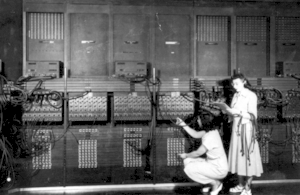Ruth Teitelbaum facts for kids
Quick facts for kids
Ruth Teitelbaum
|
|
|---|---|
| Born |
Ruth Lichterman
February 1, 1924 The Bronx, New York
|
| Died | August 9, 1986 (aged 62) Dallas, Texas
|
| Nationality | American |
| Alma mater | Hunter College |
| Occupation | Computer Programmer |
| Employer | Moore School of Electrical Engineering, University of Pennsylvania |
| Known for | Programmed on the first all-electronic digital computer (ENIAC) |
| Awards | Women in Technology International Hall of Fame |

Ruth Teitelbaum (born Ruth Lichterman) (1924–1986) was a very important person in computer history. She was one of the first computer programmers ever! Ruth was one of the original people who programmed the ENIAC computer.
The ENIAC was one of the world's first electronic digital computers. Five other amazing women worked with her. They were Jean Bartik, Betty Holberton, Kathleen Antonelli, Marlyn Meltzer, and Frances Spence.
Contents
Who was Ruth Teitelbaum?
Ruth's Early Life and Education
Ruth Lichterman was born in The Bronx, New York. Her birthday was February 1, 1924. She was the older of two children. Her parents, Sarah and Simon Lichterman, were from Russia. Her father was a teacher.
Ruth went to Hunter College. She earned a degree in Mathematics there. This helped her prepare for her future work with computers.
What did Ruth Teitelbaum do?
Ruth's Career as a Computer Programmer
Ruth Teitelbaum started working at the Moore School of Electrical Engineering. This school was part of the University of Pennsylvania. During World War II, the US Army paid the Moore School to do important calculations.
Ruth's job was to calculate ballistics trajectories. These are the paths that bullets or shells travel. This was a very complex math problem. About 80 women worked there, doing these calculations by hand. They were called "computers."
Working on the ENIAC Computer
In 1943, the Army decided to fund a new project. They wanted to build the first all-electronic digital computer. It was called the Electronic Numerical Integrator and Computer, or ENIAC. This computer was huge! It had 40 large panels, each 8 feet tall.
The programmers had to physically program the ENIAC. They used 3000 switches and many telephone cords. They would plug these cords into different trays. This helped the computer know what to do. This is why these women were called "computers"—they did the computing!
Ruth Teitelbaum worked with Marlyn Meltzer on a special part of the ENIAC project. They used older technology to calculate ballistic equations. They learned how to use the ENIAC themselves. Then, they taught others how to use it too. They also helped create the software for the ballistics calculations.
In 1946, the ENIAC computer was shown to the public. These seven women were the only programmers who worked on the original ENIAC.
Training New Programmers
After the war ended, the ENIAC computer moved. It went to the Ballistics Research Laboratory. This lab was at the Aberdeen Proving Ground. Ruth Teitelbaum went with it. She stayed there for two more years. Her job was to train the next group of ENIAC programmers. She helped pass on her knowledge.
Ruth Teitelbaum's Legacy
Ruth Teitelbaum played a key role in the rise of computers. Even though she was very important, she did not get much credit at first.
In 1997, Ruth was honored. She was put into the Women in Technology International WITI Hall of Fame. The other five original ENIAC programmers were also inducted. This recognized their amazing work.
In 2010, a documentary film was made. It was called "Top Secret Rosies: The Female "Computers" of WWII." This movie shared the stories of some of these women. It showed how much they helped during World War II. Another documentary, "The Computers", was made in 2013. It used old videos of the ENIAC team. It also had interviews with the women. They talked about their time working on the ENIAC.
Ruth Teitelbaum's Personal Life
Ruth married a man named Adolph Teitelbaum. They got their marriage license on September 17, 1948.
Ruth Teitelbaum passed away in 1986. She died in Dallas, Texas.
See also
 In Spanish: Ruth Lichterman Teitelbaum para niños
In Spanish: Ruth Lichterman Teitelbaum para niños

